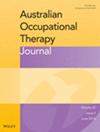Changes in lifespace and participation in community-based occupations of people with acquired brain injury: A mixed methods exploration 6 months following occupational therapy driving assessment
Abstract
Introduction
Changes arising from acquired brain injury may influence how individuals engage in valued community-based occupations such as driving. ‘Lifespace’ describes the area within which a person lives their life and represents opportunity for participation in out-of-home occupations. This study explored lifespace trajectory from pre- to 6 months post-occupational therapy driver assessment, to understand how, why, where, and with whom access and participation in community-based occupations is influenced by assessment outcome.
Methods
Adults with acquired brain injury referred for occupational therapy driver assessment were recruited to the mixed methods study involving a travel diary, lifespace assessment, and semi-structured interviews. Qualitative analysis was guided by interpretive description.
Consumer and Community Involvement
No consumer and community involvement
Results
Overall, 38 participants (55.3% male) aged 26 to 65 years reported increased lifespace 6 months following the conduct of an occupational therapy driver assessment. There was increased engagement in leisure pursuits (175%), work (23%), and social participation (21%) with reduced participation in health management (−50%) and instrumental activities of daily living (−15.4%) occupations post-OTDA. However, lifespace was significantly related to driver status, with those who had returned to driving more likely to access their community with greater frequency and less support (p < 0.001). Non-drivers experienced a deteriorating restricted lifespace. Analysis of semi-structured interviews (n = 12) created three broad themes that largely differed according to driver status: (i) ‘Being me’—reconstructing occupational identity, (ii) opportunities for participation and the influence of choice, and (iii) ‘Having connection’ and impacts on wellbeing.
Conclusion
Driver status influences the trajectory of lifespace following participation in an occupational therapy driver assessment after acquired brain injury. Drivers experienced increased lifespace with greater opportunities to control engagement in community-based occupations with flexibility and spontaneity. Non-drivers reported diminished lifespace and occupational participation trajectories and require further support to facilitate occupational adaptation to increase opportunities for engagement in away-from-home occupations.
PLAIN LANGUAGE SUMMARY
After an acquired brain injury (ABI), many people find it harder to go out and do activities away from home. A common change is losing the ability to drive. An occupational therapy driver assessment (OTDA) checks if someone is ready to drive again. This study looked at how getting back to driving, or not, affected involvement in community activities. People who returned to driving reported doing more activities, more often, and with less help. They spent more time on leisure, work, and social activities. Those who did not drive went out less, visited fewer places, and relied more on others. When they did go out, it was mostly for essential tasks like shopping and health appointments. For those not able to drive, extra services and supports are needed to help build skills. This is the first study to look at how driving is connected to taking part in community activities after a brain injury. More research is needed to confirm findings.


 求助内容:
求助内容: 应助结果提醒方式:
应助结果提醒方式:


